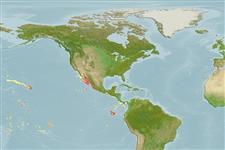Lớp phụ Cá sụn (cá mập và cá đuối) (sharks and rays) >
Carcharhiniformes (Ground sharks) >
Pentanchidae (Deepwater catsharks)
Etymology: Cephalurus: cephalus, from kephale (Gr.), head, referring to its expanded, flattened and rounded head; ailouros (Gr.), cat, probably an allusion to the vernacular “catshark,” so named for its cat-like eyes. (See ETYFish); cephalus: From kephale (Gr.), head, allusion not explained, probably referring to its expanded, flattened and rounded head, “much wider” and with larger pores compared with the similar Parmaturus xaniurus, its presumed congener at the time. (See ETYFish).
More on author: Gilbert.
Environment: milieu / climate zone / depth range / distribution range
Sinh thái học
Biển Tầng đáy biển sâu; Mức độ sâu 155 - 927 m (Ref. 244). Deep-water; 32°N - 15°S
Eastern Central Pacific: southern Baja California, Mexico and Gulf of California. Cephalurus specimens from Panama, Peru and Chile differ from Cephalurus cephalus and may represent one or more new species.
Length at first maturity / Bộ gần gũi / Khối lượng (Trọng lượng) / Age
Maturity: Lm ?, range 19 - ? cm
Max length : 28.0 cm TL con đực/không giới tính; (Ref. 244); common length : 24.0 cm TL con đực/không giới tính; (Ref. 244)
Found on the upper continental slope and outermost shelf. The expanded branchial region of this shark suggests that they are adapted to bottom areas with low dissolved oxygen levels. With little information available, reproductive mode could either be ovoviviparous (Ref. 244, 53776) or oviparous, paired eggs are laid (Ref. 50449).
Oviparous, paired eggs are laid. Embryos feed solely on yolk (Ref. 50449). Other sources describe ovoviviparity as an alternative reproductive mode (Ref. 244, 53776).
Compagno, L.J.V., 1984. FAO Species Catalogue. Vol. 4. Sharks of the world. An annotated and illustrated catalogue of shark species known to date. Part 2 - Carcharhiniformes. FAO Fish. Synop. 125(4/2):251-655. Rome: FAO. (Ref. 244)
IUCN Red List Status (Ref. 130435)
Threat to humans
Harmless
Human uses
Các nghề cá: không ích lợi (thú vị)
Thêm thông tin
Age/SizeSự sinh trưởngLength-weightLength-lengthLength-frequenciesSinh trắc họcHình thái họcẤu trùngSự biến động ấu trùngBổ xungSự phong phúBRUVS
Các tài liệu tham khảoNuôi trồng thủy sảnTổng quan nuôi trồng thủy sảnCác giốngDi truyềnElectrophoresesDi sảnCác bệnhChế biếnNutrientsMass conversion
Các công cụ
Special reports
Download XML
Các nguồn internet
Estimates based on models
Preferred temperature (Ref.
123201): 7.9 - 14.8, mean 9.5 °C (based on 31 cells).
Phylogenetic diversity index (Ref.
82804): PD
50 = 1.0000 [Uniqueness, from 0.5 = low to 2.0 = high].
Bayesian length-weight: a=0.00398 (0.00236 - 0.00672), b=3.06 (2.91 - 3.21), in cm total length, based on LWR estimates for this species & (Sub)family-body (Ref.
93245).
Mức dinh dưỡng (Ref.
69278): 3.7 ±0.4 se; based on diet studies.
Thích nghi nhanh (Ref.
120179): Rất thấp, thời gian nhân đôi của chủng quần tối thiểu là hơn 14 năm (Fec=2).
Fishing Vulnerability (Ref.
59153): Low vulnerability (18 of 100).
